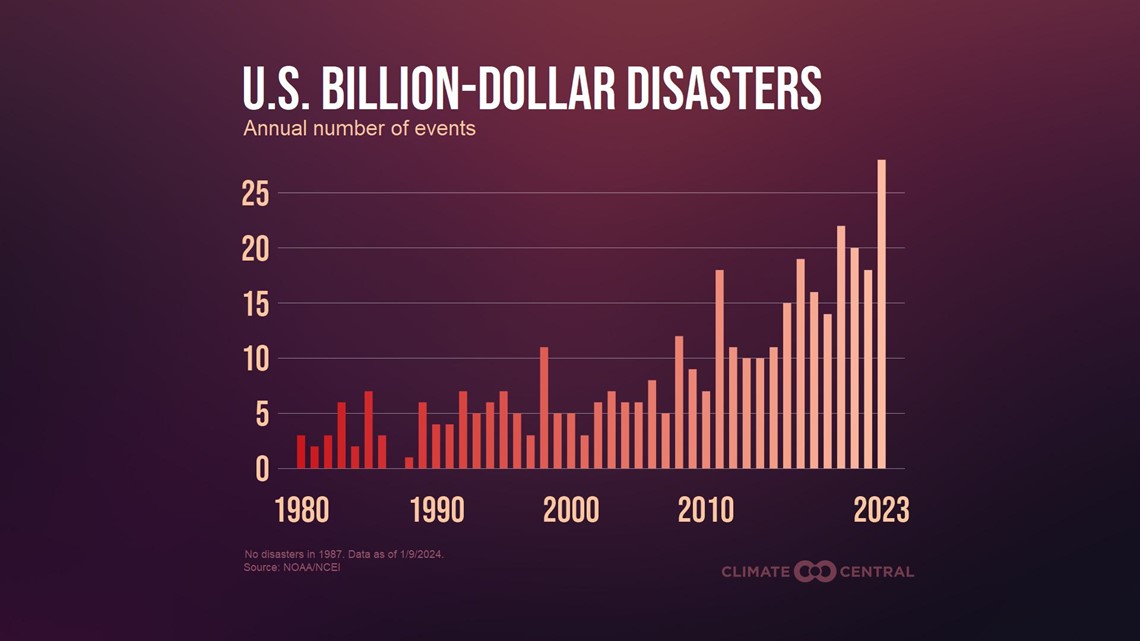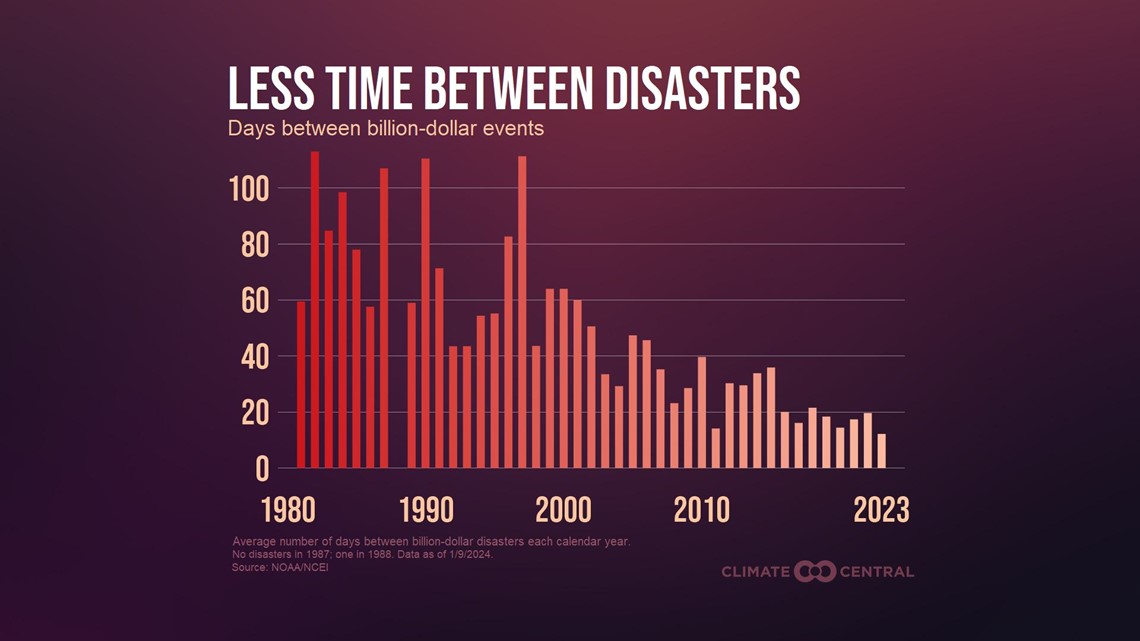HUNTSVILLE, Ala. — In 2023, global temperatures were warmer than any previous year on record. A streak of continuously record-shattering months and seasons began in June 2023 and is still ongoing.
The planet's fever is forecast to continue into 2024 with an extra warming boost from El Nino layers on top of the long-term warming trend driven by carbon pollution.
The contiguous U.S. had its 5th-hottest year on record in 2023, according to NOAA.
The seven warmest years for the U.S. have all occurred since 2012.
The annual average temperature for the contiguous U.S. in 2023 was 2.4°F above the 20th century average.
While 2023 was the 5th warmest year for the contiguous U.S. as a whole, it was the hottest year on record for Louisiana, Massachusetts, Mississippi, New Hampshire, and Texas. Cities with record-setting 2023 were clustered in the eastern U.S. - especially in the South and Southeast.


More U.S. billion-dollar disasters than ever
As the planet warms, many dangerous extreme events - from heat waves to wildfires and heavy rainfall and flooding - have become more frequent and/or intense. Extreme events like these put health and safety, livelihoods, infrastructures, and ecosystems at risk.
The U.S. was hit with a record 28 billion-dollar weather and climate disasters in 2923. The toll of these 28 events was an estimated 492 lives lost and over $93 billion in damages. The previous annual record, 22 disasters, was set in 2020.
All but four states (Alaska, Utah, Nevada, and Idaho) were affected by billion-dollar disasters in 2023.
The number of billion-dollar disasters in 2023, 2022 (18 events), 2021 (20 events), and 2020 (22 events) was far above the long-term average of 8.5 billion-dollar disasters per year since 1980.


More disasters, more often
The frequency of billion-dollar disasters has increased dramatically since 1980, fueled by heat-trapping pollution and by the growing number of people, homes, and businesses at risk.
Climate Central analysis found that the average time between billion-dollar disasters dropped from 82 days in the 1980s to 18 days on average in recent years (2018-2022).
During 2023, the average time between billion-dollar disasters was just 12 days.
Having less time between disasters can strain the resources available for communities to respond, recover quickly, and manage future risks.
Often, these risks aren't equally shared. According to the Fifth National Climate Assessment: "Low-income communities, communities of color, and Tribe and Indigenous Peoples experience high exposure and vulnerability to extreme events due to both their proximity to hazard-prone areas and lack of adequate infrastructure or disaster management resources."


Billion-dollar severe storms on the rise
Severe storms accounted for 19 (68%) of all billion-dollar disasters in 2023, and 50% of all billion-dollar disasters in the U.S. since records began in 1980.
These costly, dangerous, and deadly storms are on the rise. The U.S. experienced over six times more billion-dollar severe storms during the last 20 years (153 events form 2004-2023) than during the previous two decades (25 events from 1980-2000).
As our climate continues to warm, certain conditions favorable to thunderstorms and tornadoes are occurring more often and severe weather is expanding into historically less-active seasons and regions.
Quick climate facts: Extreme Weather Toolkit: Severe Weather
Review the latest science: Severe Storm, Supercell, and Tornado Trends
Severe storms are more likely to form under certain conditions — including high wind shear and convective available potential energy (CAPE). Since 1979, parts of the eastern U.S. have seen up to 15 more days with high CAPE during spring and summer — prime time for thunderstorms.
Studies suggest that conditions favorable to severe thunderstorms will become about 5-20% more frequent per 1.8°F of warming. Whether these changing conditions will ultimately result in the formation of more severe storms remains an active area of research.
Choosing a cooler, safer future
Every bit of avoided carbon pollution leads to safer conditions for humans and for the infrastructure and ecosystems we depend on.
The science shows that if we commit to rapid and sustained cuts in carbon pollution, it could set younger generations on a path toward a far safer future with less warming and fewer risky extreme events.
Many of the solutions we need to reduce emissions and thus choose this safer future are already available. Climate Central resources show progress and potential in every state:
- State Solar and Wind Boom to Bring U.S. Toward Climate Targets shows that current policies are projected to boost clean energy, cut carbon pollution, and bring the U.S. closer to its climate targets. See how wind and solar energy are set to grow in your state under current policies.
Climate Solutions in Every State reviews options to quickly reduce emissions in each U.S. state’s top-emitting sector.
Learn more about solutions that can bring the U.S. closer to net-zero emissions by 2050 — and ensure a safer future for younger generations.

